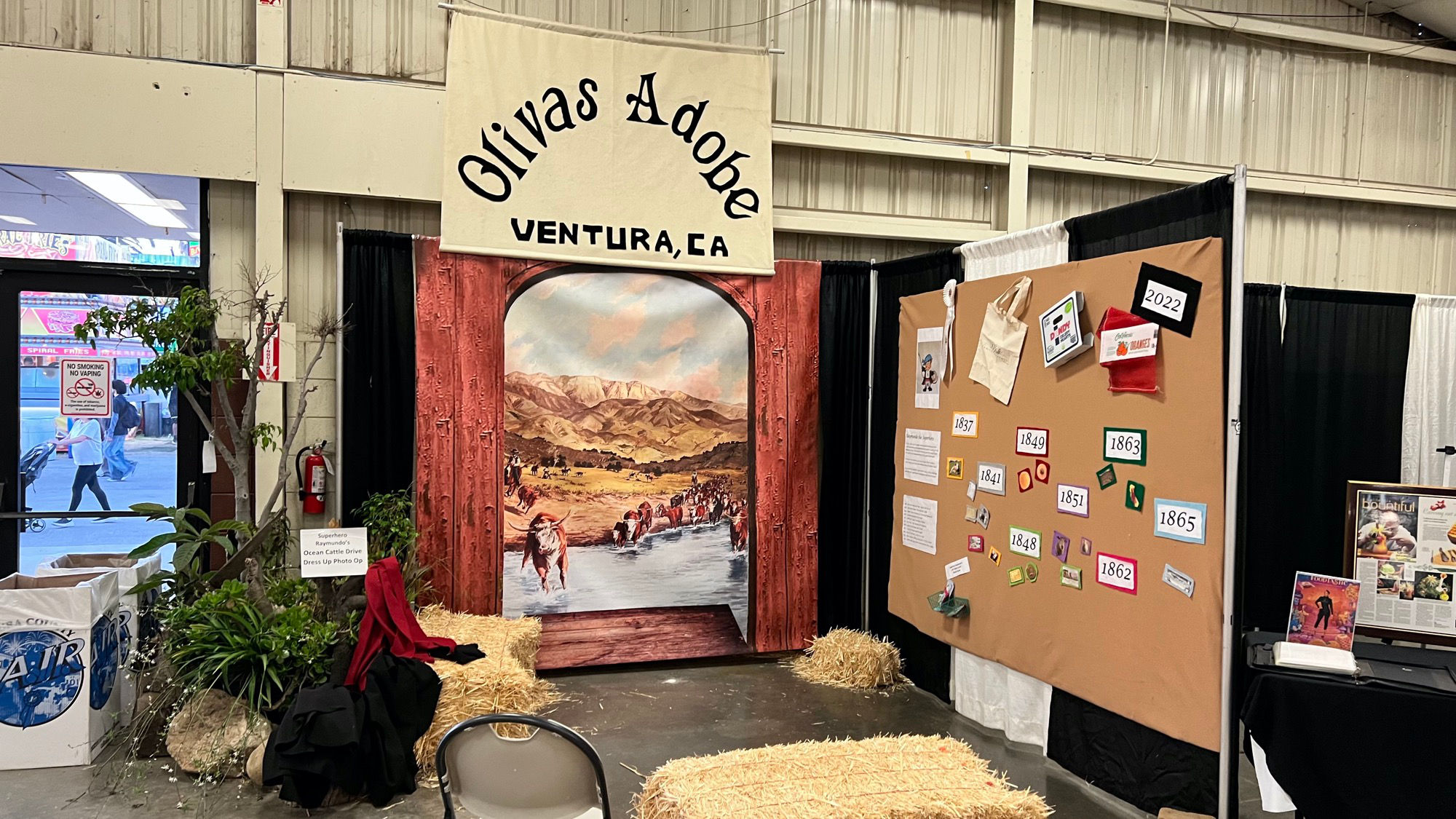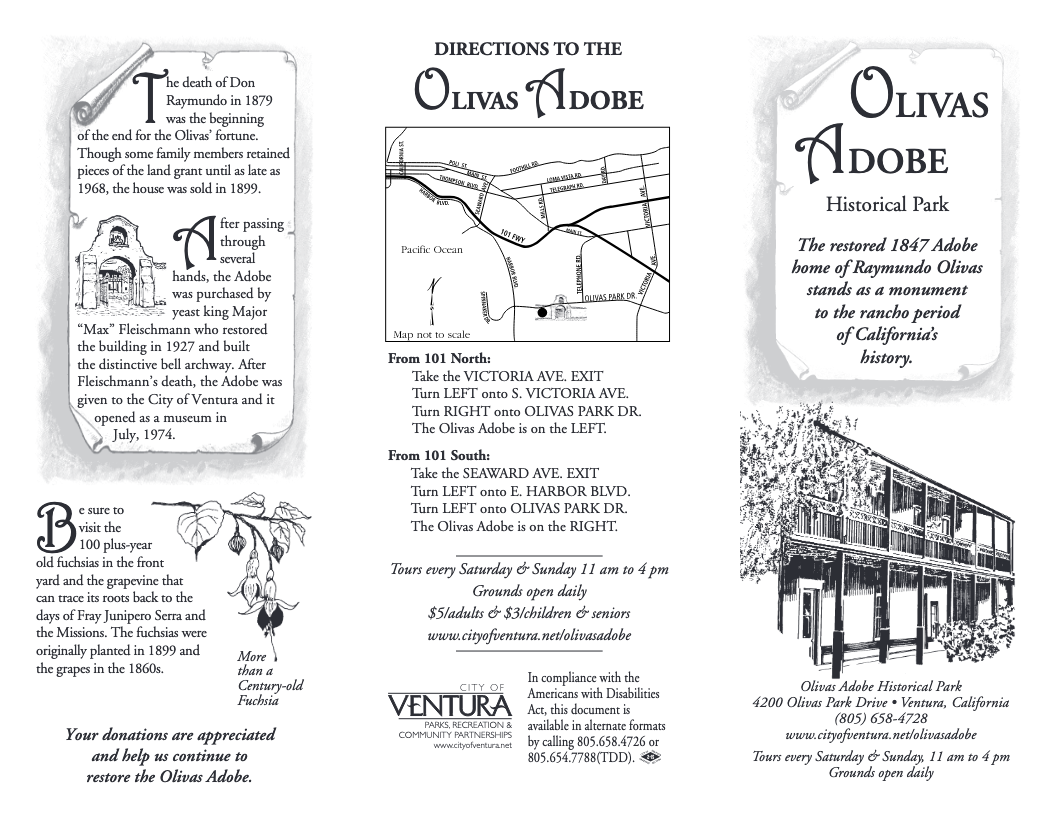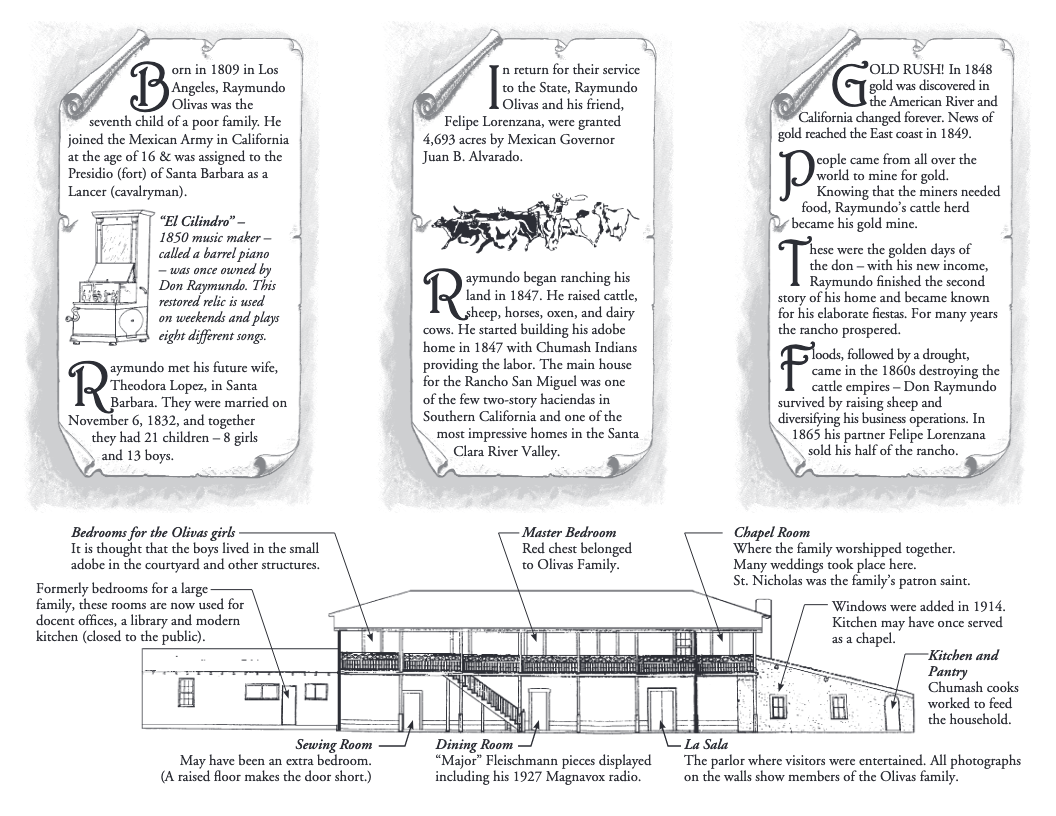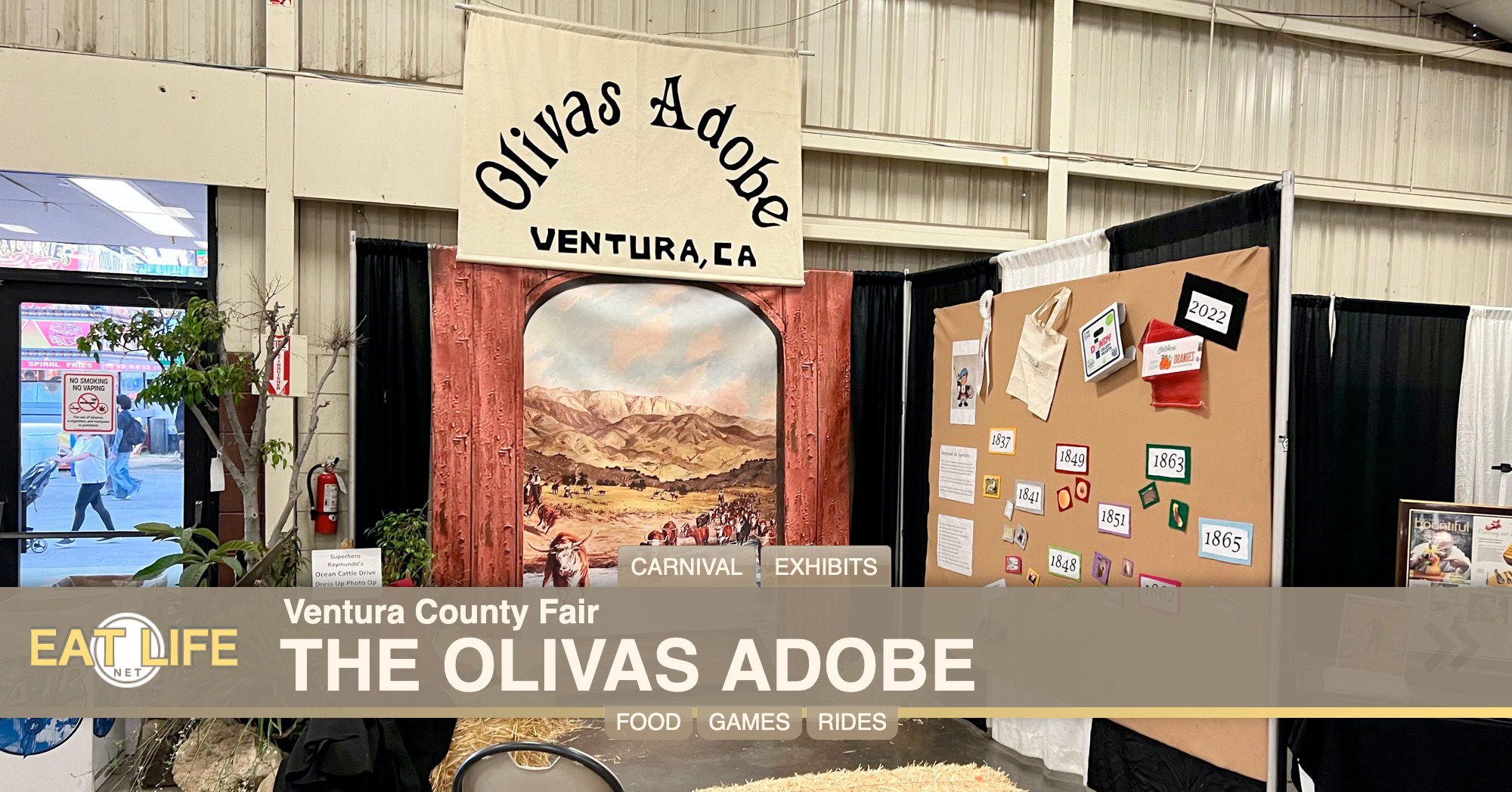
Olivas Adobe Historical Park:
The Olivas Adobe historic site features the restored two-story adobe home of Don Raymundo Olivas. Built in 1847, this Monterey-style adobe home, Historical Landmark No. 115 from the Rancho-era, celebrates Ventura’s Rancho and Latino heritage through docent-led weekend tours, educational outreach programs for school groups, and community events.History
Don Raymundo Olivas and his friend Felipe Lorenzana were granted 4,670 acres of land by Mexican Governor Juan B. Alvarado as compensation for their service to the State. Don Raymundo began ranching his land, known as Rancho San Miguel, in 1847.In 1848, gold was discovered in the American River and California history changed forever with the “Gold Rush". Individuals, referred to as minors, came from all over the world to mine for gold. Knowing the miners needed food, Don Raymundo's cattle herd became his gold mine. These were prosperous times for Don Raymundo. With his new income, Don Raymundo finished the second story of his home. His home, which remains today, was one of the few two-story haciendas in Southern California and one of the most impressive homes in the Santa Clara River Valley. For many years Rancho San Miguel prospered, and Don Raymundo became known for his elaborate parties.
In the 1860’s, droughts in California destroyed most cattle empires. Don Raymundo was able to save his empire by raising sheep instead of cattle.
In 1864, Don Raymundo’s business partner Felipe Lorenzana sold his half of Rancho San Miguel.
The death of Don Raymundo in 1879 was the beginning of the end for the Olivas' fortune. Though some family members retained pieces of the land grant until as late as 1968, the house was sold in 1899. Rebecca Olivas, youngest daughter of Don Raymundo, was the last member of the Olivas family to live at the adobe.
After passing through many hands, the Rancho San Miguel land grant, known today as the Olivas Adobe, was purchased by yeast king Max Fleischmann who restored the adobe building in 1927. Upon Fleischmann's death, the adobe was given to the City of Ventura.
- In 1972, the Olivas Adobe opened to the public as a museum.
- In 1979, the Olivas Adobe was placed on the National Register of Historical Places.
Exterior
- Fountain Gate
Enter Olivas Adobe Historical Park by the fountain gate. The succulent filled fountain is a beautiful place to view the house, the rose garden, the exhibit building and memorial grove.- Richard Senate Exhibit Building
The Olivas Adobe visitors center, named after the veteran local historian and author of numerous books, houses rotating displays of the Rancho Period of California history and the gift shop.- The Ray & Jessie Monk Volunteer Rose Garden
The Ventura Rose Society hosts a free celebration of the garden every year on Mothers Day (2nd Sunday in May) as part of the Murals and Roses special event.
To our many constant gardeners who keep the Olivas Adobe in bloom.- Memorial Grove & Bell Gate
The memorial grove of 76 trees, located outside the courtyard and beyond the bell gate and courtyard, was planted in 1976 during the nation's bicentennial.- The Olivas Owls
Each year from February to May, a pair of great horned owls returns to nest in a eucalyptus tree. A display regarding the owls is located in the Richard Senate Exhibit Hall.- Courtyard
Why was this large courtyard built? For protection? Possibly. But, it also provided the Olivas family with privacy and provided an ideal setting for parties - fiestas!- Herb Garden
The Olivas herb garden is representative of the kind of garden the Olivas family would have maintained. It is divided into 5 sections:
- Culinary - for Flavoring Foods
- Strewing - to Freshen Clothes, Floors and Carpets
- Utility - for Dyes and Pest Control
- Medicinal - for Relief and Healing
- Food - to Grow Edible Vegetables
- Horno, Cauldron & Fire Pit
Most of the cooking for the family and staff was done out-of-doors rather than in the indoors kitchen. Much of the cooking was done on the open fire pit, including the use of a cauldron for industrial purposes such as rendering animal fat or candlemaking.The horno or outdoor oven served the baking needs for the Olivas family. On days when baking was required, a fire was built in the oven early in the morning. When the fire had burned down to coals, the coals were raked out and the dish to be baked was placed inside. The wooden door was set in place to trap heat until the dish was cooked. Once heated, the horno could be used to bake bread, enchiladas, and other dishes all day long.
The Bricklayers and Allied Craftworkers Local Union Number 4 constructed the courtyard replica of an outdoor baking oven (horno) as a community service project for the union's apprentice program (apprentice craftsmen: John Anderson, Sean Marshall, and Alfonso Morales under the supervision of Field Representative Marcelo Crespi). Ron Bach Construction and Newton Building Materials donated materials and supplies.
- Mud Pit
The mud pit, source of the adobe bricks that built the Olivas Adobe. Today, the mud pit is used for brick making during Interpretive Outreach Programs for area schools.- Historic Olivas Fuchsias
Rebecca Olivas de la Riva, the adobe founders' 21st child and last member of the Olivas family to live in the Adobe, planted 5 fuchsias in the front of the house in 1899, 3 of which still thrive. The British Fuchsia Society has documented them as the world's oldest, still flowering fuchsia - a hardy "Schiller" variety with white petals around a magenta sepal. The shrub found from Mexico to South America was named fuchsia after the botanist Leonhart Fuchs in 1703.- Olivas Grape Arbor
Olivas planted these descendants of original Mission San Buenaventura vines, by way of Ojai's Tico Ranch in the 1860s, as promised in the petition for his land grant. The small, sweet, purple and thick-skinned Mission grape may be of Chilean or Mexican origin.- Olivas Hydrangea
Iva Reeder, Olivas Adobe housekeeper to Max Fleischman, planted this unknown variety of Asian origin in 1928. It blooms from spring to autumn.- Cecil Bruner Rose
In 1928 Iva Reeder, Olivas Adobe housekeeper to Max Fleischman, planted this ever blooming hybrid tea variety, also called a "Sweetheart Rose" for its large sprays of small light pink budsInterior
- Sewing Room
Every hacienda on every rancho had a room devoted to sewing. All of the clothing worn on the rancho had to be handmade. Imagine women sewing here, mending and embroidering - all under the watchful eye of Dona Teodora, Don Raymundo's wife. Sewing was hard, monotonous work, and required a great deal of time and effort.- Dining Room
This room is believed to be the main dining room for the Olivas family. However, it was also the entertainment center of Max Fleischmann, the last man to own the house and maintain it as a private residence. Mr. Fleischmann bought the property in 1927. After his death in 1951, the Fleischmann Foundation gave the Adobe to the City of Ventura with the provision that it be used as a living history museum. Therefore, this room is kept as Mr. Fleischmann left it as a memorial for his gift to the city.- Kitchen
Although much of the cooking was done out of doors, the kitchen was a room of constant activity. The meals of the day would have been prepared by skilled Chumash servants. Beef, mutton, chicken, vegetables and fruits were important parts of the menu, as well as breads and stone ground corn tortillas. During fiestas, hundreds of meals were served, and the kitchen was a place of nonstop preparations.- Girls Bedroom
Don Raymundo's 8 daughters slept in this room. It was accepted in those days that more than one person slept in a bed, and custom dictated that daughters slept near their parents. Young marriages were common, so it is unlikely that all 8 girls would have been present at one time. Don Raymundo's 13 sons may have slept in rooms enclosed on each end of the balcony or in the small adobe building across the courtyard.- Master Bedroom
This room was carefully attended by the servants and family. Here the pacing footsteps of Don Raymundo echoed as he pondered the effects of the floods of 1860 and the terrible drought and economic depression of 1861 - 1862. It is believed that Don Raymundo died in this room on February 24, 1879 at almost 70 years of age.- Chapel
The family chapel was the spiritual center of the Rancho. Weddings, baptisms and daily prayers made this an active room, where the flicker of votive candles and the hushed whisper of prayer would fill it each night before the family retired.

Olivas Adobe Historical Park:
The restored 1847 Adobe home of Raymundo Olivas stands as a monument to the rancho period of California’s history.
- The death of Don Raymundo in 1879 was the beginning of the end for the Olivas’ fortune. Though some family members retained pieces of the land grant until as late as 1968, the house was sold in 1899
- After passing through several hands, the Adobe was purchased by yeast king Major “Max" Fleischmann who restored the building in 1927 and built the distinctive bell archway. After Fleischmann’s death, the Adobe was given to the City of Ventura and it opened as a museum in July, 1974.
- Born in 1809 in Los Angeles, Raymundo Olivas was the seventh child of a poor family. He joined the Mexican Army in California at the age of 16 & was assigned to the Presidio (fort) of Santa Barbara as a Lancer (cavalryman)
- Raymundo met his future wife, Theodora Lopez, in Santa Barbara. They were married on November 6, 1832, and together they had 21 children – 8 girls and 13 boys.
- In return for their service to the State, Raymundo Olivas and his friend, Felipe Lorenzana, were granted 4,693 acres by Mexican Governor Juan B. Alvarado.
- Raymundo began ranching his land in 1847. He raised cattle, sheep, horses, oxen, and dairy cows. He started building his adobe home in 1847 with Chumash Indians providing the labor. The main house for the Rancho San Miguel was one of the few two-story haciendas in Southern California and one of the most impressive homes in the Santa Clara River Valley.
- GOLD RUSH! In 1848 gold was discovered in the American River and California changed forever. News of gold reached the East coast in 1849.
- People came from all over the world to mine for gold. Knowing that the miners needed food, Raymundo’s cattle herd became his gold mine.
- These were the golden days of the don – with his new income, Raymundo finished the second story of his home and became known for his elaborate fiestas. For many years the rancho prospered.
- Floods, followed by a drought, came in the 1860s destroying the cattle empires – Don Raymundo survived by raising sheep and diversifying his business operations. In 1865 his partner Felipe Lorenzana sold his half of the rancho.
More than a Century Old Fuchsia
Be sure to visit the 100 plus-year old fuchsias in the front yard and the grapevine that can trace its roots back to the days of Fray Junipero Serra and the Missions. The fuchsias were originally planted in 1899 and the grapes in the 1860s.https://ca-ventura.civicplus.com/DocumentCenter/View/3192/Olivas-Adobe-Brochure-PDF





